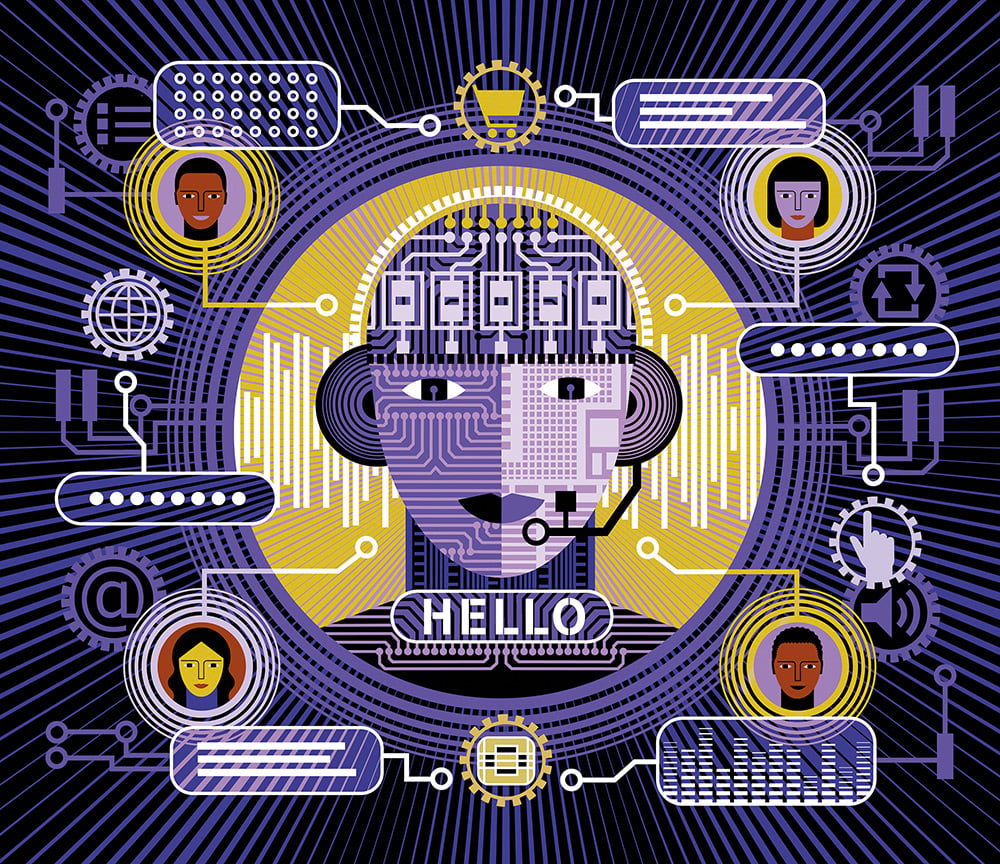
Illustration by The Balbusso Twins
Please remember that the value of an investment can fall and you may not get back the amount invested.
In combat, the US Air Force follows a protocol called the OODA loop: observe, orient, decide and act. Experience shows that agile pilots who cycle through it quickest are more likely to win dogfights.
The process also applies to business. We’ve observed that ‘technical leaders’ often gain the upper hand when stakes are high precisely because their expertise helps them speed through the loop to outmanoeuvre the competition. These chief executives don’t need to write and test software or configure datacentres themselves but do require a deep understanding of the technologies and complexities involved.
We live in a world of exponential technological progress, where companies constantly have to adapt to innovations. But the pace of evolution isn’t constant. Sometimes, there are periods of relative stability.
Take the 2010s. We knew the main parts of the technology stack – the internet, mobile communication, satellite navigation, etc – and the challenge was to find novel, effective uses for them.
However, artificial intelligence means the 2020s might be more like the preceding period when many of those foundational technologies were still being established, and computer capabilities were in flux. At times like these, you want a leader who doesn’t need consultants to tell them what a developing technology can and can’t do and who can spot how their business can best exploit it to move quickly and gain a first-mover advantage.
So, as an investor in exceptional growth, Scottish Mortgage aims to own a selection of companies led by technical leaders that have plenty of potential AI applications. This led us to reinvest in Meta last year.
Zuckerberg’s conviction
Founder Mark Zuckerberg’s credentials hardly need rehashing. Ever since coding the original version of Facebook in his Harvard University dorm room, he has repeatedly demonstrated an ability to turn emerging technologies into practical products at speed.
“Some of the most rewarding work involves getting deep into the details of technical projects,” he wrote years later, after building an AI system as a personal challenge to identify visitors to his home and entertain his daughter.
To illustrate how Zuckerberg’s deep knowledge can pay off, consider his outsized purchase of NVIDIA’s top-of-the-range H100 AI chips in 2022. Meta needed extra processing power to improve its Reels short video recommendations to catch up with ByteDance’s TikTok. Rather than simply buying enough chips to achieve this, Zuckerberg doubled the order. He foresaw that Meta would soon need extra capacity, even though he didn’t yet know what for.
This aggressive investment in infrastructure was a non-obvious use of capital at the time. But it paid off. When OpenAI revealed its ChatGPT chatbot, others rushed to buy H100s, constraining supply and causing a price spike. However, Meta was able to develop its generative AI large language model (LLM) Llama and the services it powers more quickly and cheaply than it could have done otherwise.
When we owned Meta in the past, we recognised Zuckerberg’s ability to allocate capital as a strength, as demonstrated by his acquisition of Instagram and WhatsApp. He saw the potential in these assets long before others. However, we sold over concerns that regulators would prevent further takeovers of this scale. What’s now changed is that AI gives Zuckerberg new ways to exploit his skill at spending on the right things.
Meta has many ways to profit from Llama. It has already made its platforms more attractive to advertisers by letting them automatically generate text tailored to their brands and adjust images to suit whether they appear on Facebook Stories, Instagram’s Explore grid, third-party apps or elsewhere.
Even more promising is Meta’s use of Llama to power chatbots for businesses. The AI agents can handle customer queries, take bookings and make sales on Messenger and WhatsApp. About three billion people use one or both of these chat apps, but historically their revenues have been meagre. Now, there’s a massive opportunity to make money.
Intriguingly, Meta has made Llama open source, meaning others can access, modify and distribute it for free. That’s in stark contrast to OpenAI, Google and others that lock their code away and charge a fee for access to their models to recoup some of the billions of dollars of training costs.
Zuckerberg’s insight is that by making Llama free for others to use on their own hardware, the wider development community will help find ways to reduce its running costs, which might be more valuable to Meta in the long run. Furthermore, he undermines his competitors’ business models in the process.
Shopify’s AI shift
Shopify is another portfolio company benefiting from technical leadership. Chief executive Tobi Lütke taught himself how to program in BASIC on an Amstrad computer in the 1990s and continues to find inspiration in learning computer languages. In fact, he credits one – Nix and its focus on reproducibility – with directly influencing a human resources shake-up that led Shopify to become more consistent and efficient at allocating staff to projects.
Lütke has also applied his engineer’s mindset to Shopify’s core offering: software to help merchants sell goods online. The company initially focused on providing smaller businesses with a complete solution. But over the past decade, it has also targeted larger, more lucrative enterprise customers. These clients tend to want more customisation.
So the firm launched Shopify Plus, which offers functions such as product search and shopping carts as individual modules. And more recently, it added Shopify Functions, which lets merchants override the software’s default behaviours by adding their own code.
Shopify could only achieve this because, in 2016, Lütke decided to shift its service’s underlying architecture from a monolithic, highly interconnected model, in which even a small change to the system could cause a cascade of problems, to a component-based design. This meant each part would have its own boundary and be developed and maintained independently.
His critical insight was that your architecture defines the range of business strategies you can pursue.
Today, Shopify is at another turning point. Lütke has told staff that AI will lead to a “decade of high velocity and massive change” and should become their focus.

Early efforts include Sidekick, a chatbot assistant that makes it easy for merchants to use natural-language requests to run their stores, such as by offering sale discounts or altering which products have prominence. In addition, Shopify is making things easier for customers with better-informed search results, recognising, for example, that a request for ‘Christmas-themed shoes’ should surface red-and-green footwear.
It’s not yet clear how AI will reshape commerce. Perhaps virtual agents will eventually anticipate our needs and negotiate prices for us. However, having a technical leader gives Shopify the best chance of strategic flexibility in the future.
Roblox chats
Generative AI is also reshaping what’s possible at Roblox. Its chief executive, David Baszucki, began his career by writing a popular 2D physics simulator for the Macintosh computer in the 1980s. Its success inspired him to develop a 3D follow-up that took advantage of the cloud and people’s ability to play together, which became the video game platform.
One of the company’s fundamental strengths has been Baszucki’s unwavering focus on what’s important to Roblox’s audience. For example, the firm has prioritised making creators’ games run without lag when many players are interacting rather than trying to provide photorealistic graphics or more video frames per second.
The firm is taking a similar pragmatic approach to AI. For example, in February it began using an LLM to automatically translate chats in real time between players conversing in any of 16 supported languages. It has also developed tools that suggest code to game developers and help them design characters and other virtual items.
These steps magnify the experiences creators can deliver on Roblox, encouraging players to spend more time and money on the platform. However, the firm has avoided using the most powerful AI models, as processing each query would have been cost-prohibitive.
Instead, it has contributed to more economical open-source alternatives based on Baszucki’s understanding that Roblox’s competitive advantage lies in the wealth of proprietary data to which it can apply those models.
Spotify and artificial artists
Spotify’s founder, Daniel Ek, is a fourth example of a technical leader and the one who introduced me to ChatGPT. He was gripped from the start, becoming one of the first to license OpenAI’s technology to power Spotify’s AI DJ, which entertains subscribers between tracks.
Generative AI is likely to lead to an explosion in new material on the audio platform. It will make it easier to remix existing songs and create new ones. Entirely manufactured artists may even become commonplace. The ramifications are also huge for the podcasts and audiobooks Spotify hosts.
One of Spotify’s challenges has been agreeing on how much the record labels and creators earn from each streamed song. How will that change in a world of AI content? How will the service’s algorithms account for different subscribers’ perceptions of the material? And how will Spotify avoid becoming oversaturated with artificial artists?
These are unanswered questions. However, having somebody who deeply understands the technology and is agile in decision-making is invaluable when navigating a rapidly changing environment.
Scottish Mortgage, too, must keep cycling through the OODA loop to observe, orient, decide and act regarding how artificial intelligence affects our clients' portfolios. But, as discussed, that goes far beyond thinking about the technology.
The coming changes will play out over many years, and we will gain our edge from broad exposure to smart, adaptable leaders from whom we can learn. In the AI age, partnering with such entrepreneurs has never been more critical.

Important information
The views expressed in this article should not be considered as advice or a recommendation to buy, sell or hold a particular investment. The article contains information and opinion on investments that does not constitute independent investment research, and is therefore not subject to the protections afforded to independent research.
Some of the views expressed are not necessarily those of Baillie Gifford. Investment markets and conditions can change rapidly, therefore the views expressed should not be taken as statements of fact nor should reliance be placed on them when making investment decisions.
Baillie Gifford & Co Limited is wholly owned by Baillie Gifford & Co. Both companies are authorised and regulated by the Financial Conduct Authority and are based at: Calton Square, 1 Greenside Row, Edinburgh EH1 3AN.
The investment trusts managed by Baillie Gifford & Co Limited are listed on the London Stock Exchange and are not authorised or regulated by the Financial Conduct Authority.
A Key Information Document is available by visiting bailliegifford.com
115444 10049534



